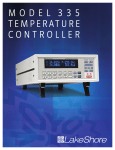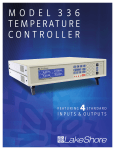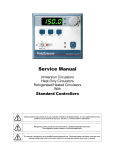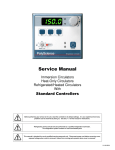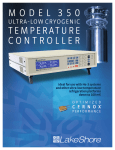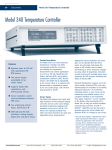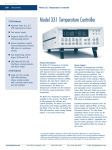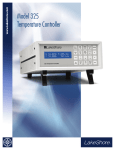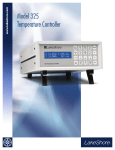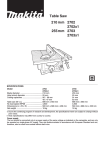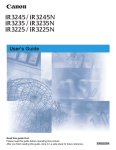Download Model 335 - Lake Shore Cryotronics, Inc.
Transcript
Model 335 Temperature Controller Model 335 Temperature Controller DD Operates down to 300 mK with appropriate NTC RTD sensors DD Two sensor inputs DD Two configurable PID control loops providing 50 W and 25 W or 75 W and 1W DD Autotuning automatically calculates PID parameters DD Automatically switch sensor inputs using zones to allow continuous measurement and control from 300 mK to 1 505 K DD Custom display set-up allows you to label each sensor input Introduction Designed with the user and ease of use in mind, the Model 335 temperature controller offers many user-configurable features and advanced functions that until now have been reserved for more expensive, high-end temperature controllers. The Model 335 is the first twochannel temperature controller available with user configurable heater outputs delivering a total of 75 W of low noise heater power—50 W and 25 W, or 75 W and 1 W. With that much heater power packed into an affordable halfrack sized instrument, the Model 335 gives you more power and control than ever. DD USB and IEEE-488 interfaces DD Supports diode, RTD, and thermocouple temperature sensors DD Sensor excitation current reversal eliminates thermal EMF errors for resistance sensors DD ±10 V analog voltage output, alarms, and relays DD CE certification Control outputs are equipped with both hardware and software features allowing you, and not your temperature controller, to easily control your experiments. Output one functions as a current output while output two can be configured in either current or voltage mode. With output two in voltage mode, it functions as a ±10 V analog output while still providing 1 W of heater power and full closed loop proportional-integral-derivative (PID) control capability. Alarms and relays are included to help automate secondary control functions. The improved autotuning feature of the Model 335 can be used to automatically calculate PID control parameters, so you spend less time tuning your controller and more time conducting experiments. DD Full 3 year standard warranty The Model 335 supports the industry’s most advanced line of cryogenic temperature sensors as manufactured by Lake Shore, including diodes, resistance temperature detectors (RTDs), and thermocouples. The controller’s zone tuning feature allows you to measure and control temperatures seamlessly from 300 mK to over 1 500 K. This feature automatically p. 2 switches temperature sensor inputs when your temperature range goes beyond the useable range of a given sensor. You’ll never again have to be concerned with temperature sensor over or under errors and measurement continuity issues. The intuitive front panel layout and keypad logic, bright vacuum fluorescent display, and LED indicators enhance the user-friendly front panel interface of the Model 335. Four standard display modes are offered to accommodate different instrument configurations and user preferences. Say goodbye to sticky notes and hand written labels, as the ability to custom label sensor inputs eliminates the guesswork in remembering or determining the location to which a sensor input is associated. These features, combined with USB and IEEE-488 interfaces and intuitive menu structure and logic supports efficiency and ease of use. As a replacement to our popular Model 331 and 332 temperature controllers, the Model 335 offers software emulation modes for literal drop-in compatibility. The commands you are accustomed to sending to the Model 331 and 332 will either be interpreted directly or translated to the most appropriate Model 335 setting. The Model 335 comes standardequipped with all of the functionality of the controllers it replaces, but offers additional features that save you time and money. With the Model 335, you get a temperature controller you control from the world leader in cryogenic thermometry. Lake Shore Cryotronics, Inc. | t. 614.891.2243 | f. 614.818.1600 | info@lakeshore.com | www.lakeshore.com Sensor inputs The Model 335 offers two standard sensor inputs that are compatible with diode and RTD temperature sensors. The field-installable Model 3060 option adds thermocouple functionality to both inputs. Sensor inputs feature a high-resolution 24-bit analog-to-digital converter and each of the two powered outputs function as separate current sources. Both sensor inputs are optically isolated from other circuits to reduce noise and to deliver repeatable sensor measurements. Current reversal eliminates thermal electromagnetic field (EMF) errors in resistance sensors. Ten excitation currents facilitate temperature measurement and control down to 300 mK using appropriate negative temperature coefficient (NTC) RTDs. Autorange mode automatically scales excitation current in NTC RTDs to reduce self heating at low temperatures as sensor resistance changes by many orders of magnitude. Temperatures down to 1.4 K can be measured and controlled using silicon or GaAlAs diodes. Software selects the appropriate excitation current and signal gain levels when the sensor type is entered via the instrument front panel. To increase your productivity, the unique zone setting feature automatically switches sensor inputs, enabling you to measure temperatures from 300 mK to over 1 500 K without interrupting your experiment. The Model 335 includes standard temperature sensor response curves for silicon diodes, platinum RTDs, ruthenium oxide RTDs, and thermocouples. Non-volatile memory can also store up to 39 200-point CalCurves for Lake Shore calibrated temperature sensors or user curves. A built-in SoftCal algorithm can be used to generate curves for silicon diodes and platinum RTDs that can be stored as user curves. Temperature sensor calibration data can be easily loaded into the Model 335 temperature controller and manipulated using the Lake Shore curve handler software program. Temperature control Providing a total of 75 W of heater power, the Model 335 is the most powerful half rack temperature controller available. Designed to deliver very clean heater power, precise temperature control is ensured throughout your full scale temperature range for excellent measurement reliability, efficiency and throughput. Two independent PID control outputs can be configured to supply 50 W and 25 W or 75 W and 1 W of heater power. Precise control output is calculated based on your temperature setpoint and feedback from the control sensor. Wide tuning parameters accommodate most cryogenic cooling systems and many high-temperature ovens commonly used in laboratories. PID values can be manually set for fine control or the improved autotuning feature can automate the tuning process. The Model 335 autotuning method calculates PID parameters and provides feedback to help build zone tables. The setpoint ramp feature provides smooth, continuous setpoint changes and predictable approaches to setpoint without the worry of overshoot or excessive settling times. The instrument’s zone tuning feature automatically switches temperature sensor inputs when your temperature range goes beyond the useable range of a given sensor. This feature combined with the instrument’s ability to scale the sensor excitation through ten pre-loaded current settings allows the Model 335 to provide continuous measurement and control from 300 mK to 1 505 K. Both control outputs are variable DC current sources referenced to chassis ground. As a factory default, outputs 1 and 2 provide 50 W and 25 W of continuous power respectively, both to a 50 Ω or 25 Ω load. For increased functionality, output 2 can also be set to voltage mode. When set to voltage mode, it functions as a ±10 V analog output while still providing 1 W of heater power and full closed loop PID control capability. While in this mode, output 1 can provide up to 75 W of heater power to a 25 Ω load. Temperature limit settings for inputs are provided as a safeguard against system damage. Each input is assigned a temperature limit, and if any input exceeds that limit, both control channels are automatically disabled. Interface The Model 335 is standard equipped with universal serial bus (USB) and parallel (IEEE488) interfaces. In addition to gathering data, nearly every function of the instrument can be controlled via computer interface. You can download the Lake Shore curve handler software program to your computer to easily enter and manipulate sensor calibration curves for storage in the instrument’s non-volatile memory. The USB interface emulates an RS-232C serial port at a fixed 57 600 baud rate, but with the physical plug-ins of a USB. It also allows you to download firmware upgrades, ensuring the most current firmware version is loaded into your instrument without having to physically change your instrument. Both sensor inputs are equipped with a high and low alarm which offers latching and nonlatching operation. The two relays can be used in conjunction with the alarms to alert you of a fault condition and perform simple on-off control. Relays can be assigned to any alarm or operated manually. The ±10 V analog voltage output can be configured to send a voltage proportional to temperature to a strip chart recorder or data acquisition system. You may select the scale and data sent to the output, including temperature or sensor units. Model 335 rear panel 8 6 1 2 3 4 5 6 7 8 5 7 1 2 p. 3 3 Sensor input connectors Terminal block (analog outputs/relays) USB interface IEEE-488 interface Line input assembly Output 2 heater Output 1 heater Thermocouple option inputs 4 Lake Shore Cryotronics, Inc. | t. 614.891.2243 | f. 614.818.1600 | info@lakeshore.com | www.lakeshore.com Configurable display The Model 335 offers a bright, vacuum fluorescent display that simultaneously displays up to four readings. You can display both control loops, or if you need to monitor just one input, you can display just that one in greater detail. Or you can custom configure each display location to suit your experiment. Data from any input can be assigned to any of the locations, and your choice of temperature sensor units can be displayed. For added convenience, you can also custom label each senor input, eliminating the guesswork in remembering or determining the location to which a sensor input is associated. Sensor selection Sensor temperature range (sensors sold separately) Diodes Positive temperature coefficient RTDs Negative temperature coefficient RTDs Two input/one loop display with labels Standard display option featuring two inputs and associated outputs. Custom display with labels Reading locations can be user configured to accommodate application needs. Here, the input names are shown above the measurement readings along with the designated input letters. Thermocouples Option—3060 Silicon diode Silicon diode Silicon diode Silicon diode Silicon diode Silicon diode GaAlAs diode GaAlAs diode GaAlAs diode 100 Ω platinum 100 Ω platinum Rhodium-iron Rhodium-iron Cernox™ Cernox™ Cernox™ Cernox™ Cernox™ Germanium Germanium Carbon-glass Carbon-glass Carbon-glass Rox™ Rox™ Rox™ Type K Type E ChromelAuFe 0.07% Model DT-670-SD DT-670E-BR DT-414 DT-421 DT-470-SD DT-471-SD TG-120-P TG-120-PL TG-120-SD PT-102/3 PT-111 RF-800-4 RF-100T/U CX-1010 CX-1030-HT CX-1050-HT CX-1070-HT CX-1080-HT GR-300-AA GR-1400-AA CGR-1-500 CGR-1-1000 CGR-1-2000 RX-102 RX-103 RX-202 9006-006 9006-004 9006-002 Useful range 1.4 K to 500 K 30 K to 500 K 1.4 K to 375 K 1.4 K to 325 K 1.4 K to 500 K 10 K to 500 K 1.4 K to 325 K 1.4 K to 325 K 1.4 K to 500 K 14 K to 873 K 14 K to 673 K 1.4 K to 500 K 1.4 K to 325 K 0.3 K to 325 K1 0.3 K to 420 K1, 3 1.4 K to 420 K1 4 K to 420 K1 20 K to 420 K1 0.35 K to 100 K3 1.8 K to 100 K3 1.4 K to 325 K 1.7 K to 325 K2 2 K to 325 K2 0.3 K to 40 K3 1.4 K to 40 K 0.3 K to 40 K3 3.2 K to 1505 K 3.2 K to 934 K 1.2 K to 610 K Magnetic field use T ≥ 60 K & B ≤ 3 T T ≥ 60 K & B ≤ 3 T T ≥ 60 K & B ≤ 3 T T ≥ 60 K & B ≤ 3 T T ≥ 60 K & B ≤ 3 T T ≥ 60 K & B ≤ 3 T T > 4.2 K & B ≤ 5 T T > 4.2 K & B ≤ 5 T T > 4.2 K & B ≤ 5 T T > 40 K & B ≤ 2.5 T T > 40 K & B ≤ 2.5 T T > 77 K & B ≤ 8 T T > 77 K & B ≤ 8 T T > 2 K & B ≤ 19 T T > 2 K & B ≤ 19 T T > 2 K & B ≤ 19 T T > 2 K & B ≤ 19 T T > 2 K & B ≤ 19 T Not recommended Not recommended T > 2 K & B ≤ 19 T T > 2 K & B ≤ 19 T T > 2 K & B ≤ 19 T T > 2 K & B ≤ 10 T T > 2 K & B ≤ 10 T T > 2 K & B ≤ 10 T Not recommended Not recommended Not recommended Non-HT version maximum temperature: 325 K Low temperature limited by input resistance range 3 Low temperature specified with self-heating error: ≤ 5 mK 1 2 Intuitive menu structure Logical navigation allows you to spend more time on research and less time on setup. Model 3060 thermocouple input option The field installable Model 3060 thermocouple input option adds thermocouple functionality to both inputs. While the option can be easily removed, this is not necessary as the standard inputs remain fully functional when they are not being used to measure thermocouple temperature sensors. Calibration for the option is stored on the card so it can be installed in the field and used with multiple Model 335 temperature controllers without recalibration. p. 4 Silicon diodes are the best choice for general cryogenic use from 1.4 K to above room temperature. Silicon diodes are economical to use because they follow a standard curve and are interchangeable in many applications. They are not suitable for use in ionizing radiation or magnetic fields. Cernox™ thin-film RTDs offer high sensitivity and low magnetic field-induced errors over the 0.3 K to 420 K temperature range. Cernox sensors require calibration. Platinum RTDs offer high uniform sensitivity from 30 K to over 800 K. With excellent reproducibility, they are useful as thermometry standards. They follow a standard curve above 70 K and are interchangeable in many applications. Lake Shore Cryotronics, Inc. | t. 614.891.2243 | f. 614.818.1600 | info@lakeshore.com | www.lakeshore.com Typical sensor performance Example Lake Shore sensor Temperature Nominal resistance/ voltage Typical sensor sensitivity4 Measurement resolution: temperature equivalents Electronic accuracy: temperature equivalents Temperature accuracy including electronic accuracy, CalCurve™, and calibrated sensor Electronic control stability5: temperature equivalents Silicon diode DT-670-CO-13 with 1.4H calibration Silicon diode DT-470-SD-13 with 1.4H calibration GaAlAs diode TG-120-SD with 1.4H calibration 1.4 K 77 K 300 K 500 K 1.4 K 77 K 300 K 475 K 1.4 K 77 K 300 K 475 K 30 K 77 K 300 K 500 K 0.3 K 0.5 K 4.2 K 300 K 1.4 K 4.2 K 77 K 420 K 0.35 K 1.4 K 4.2 K 100 K 1.8 K 4.2 K 10 K 100 K 1.4 K 4.2 K 77 K 300 K 0.5 K 1.4 K 4.2 K 40 K 75 K 300 K 600 K 1505 K 1.664 V 1.028 V 0.5596 V 0.0907 V 1.6981 V 1.0203 V 0.5189 V 0.0906 V 5.3909 V 1.4222 V 0.8978 V 0.3778 V 3.660 Ω 20.38 Ω 110.35 Ω 185.668 Ω 2322.4 Ω 1248.2 Ω 277.32 Ω 30.392 Ω 26566 Ω 3507.2 Ω 205.67 Ω 45.03 Ω 18225 Ω 449 Ω 94 Ω 2.7 Ω 15288 Ω 1689 Ω 253 Ω 2.8 Ω 103900 Ω 584.6 Ω 14.33 Ω 8.55 Ω 3701 Ω 2005 Ω 1370 Ω 1049 Ω -5862.9 µV 1075.3 µV 13325 µV 49998.3 µV -12.49 mV/K -1.73 mV/K -2.3 mV/K -2.12 mV/K -13.1 mV/K -1.92 mV/K -2.4 mV/K -2.22 mV/K -97.5 mV/K -1.24 mV/K -2.85 mV/K -3.15 mV/K 0.191 Ω/K 0.423 Ω/K 0.387 Ω/K 0.378 Ω/K -10785 Ω/K -2665.2 Ω/K -32.209 Ω/K -0.0654 Ω/K -48449 Ω/K -1120.8 Ω/K -2.4116 Ω/K -0.0829 Ω/K -193453 Ω/K -581 Ω/K -26.6 Ω/K -0.024 Ω/K -26868 Ω/K -862 Ω/K -62.0 Ω/K -0.021 Ω/K -520000 Ω/K -422.3 Ω/K -0.098 Ω/K -0.0094 Ω/K -5478 Ω/K -667 Ω/K -80.3 Ω/K -1.06 Ω/K 15.6 µV/K 40.6 µV/K 41.7 µV/K 36.006 µV/K 0.8 mK 5.8 mK 4.3 mK 4.7 mK 0.8 mK 5.2 mK 4.2 mK 4.5 mK 0.2 mK 16 mK 7 mK 6.4 mK 1.1 mK 0.5 mK 5.2 mK 5.3 mK 8.5 µK 26 µK 140 µK 23 mK 20 µK 196 µK 1.9 mK 18 mK 4 µK 41 µK 56 µK 6.3 mK 28 µK 91 µK 73 µK 7.1 mK 13 µK 63 µK 4.6 mK 16 mK 41 µK 128 µK 902 µK 62 mK 26 mK 10 mK 10 mK 11 mK ±13 mK ±76 mK ±47 mK ±40 mK ±13 mK ±68 mK ±44 mK ±38 mK ±8.8 mK ±373 mK ±144 mK ±114 mK ±13 mK ±10 mK ±39 mK ±60 mK ±0.1 mK ±0.2 mK ±3.8 mK ±339 mK ±0.3 mK ±2.1 mK ±38 mK ±338 mK ±48 µK ±481 µK ±1.8 mK ±152 mK ±302 µK ±900 µK ±1.8 mK ±177 mK ±0.1 mK ±0.8 mK ±108 mK ±760 mK ±0.5 mK ±1.4 mK ±8 mK ±500 mK ±0.25 K7 ±0.038 K7 ±0.184 K7 ±0.73 K7 ±25 mK ±98 mK ±79 mK ±90 mK ±25 mK ±90 mK ±76 mK ±88 mK ±21 mK ±395 mK ±176 mK ±164 mK ±23 mK ±22 mK ±62 mK ±106 mK ±3.6 mK ±4.7 mK ±8.8 mK ±414 mK ±5.3 mK ±7.1 mK ±54 mK ±403 mK ±4.2 mK ±4.7 mK ±6.8 mK ±175 mK ±4.5 mK ±5.1 mK ±6.8 mK ±200 mK ±4.1 mK ±4.8 mK ±133 mK ±865 mK ±5 mK ±6.4 mK ±24 mK ±537 mK Calibration not available from Lake Shore ±1.6 mK ±11.6 mK ±8.7 mK ±9.4 mK ±1.6 mK ±10.4 mK ±8.4 mK ±9 mK ±0.4 mK ±32 mK ±14 mK ±13 mK ±2.2 mK ±1.0 mK ±10.4 mK ±10.6 mK ±17 µK ±52 µK ±280 µK ±46 mK ±40 µK ±392 µK ±3.8 mK ±36 mK ±8 µK ±82 µK ±112 µK ±12.6 mK ±56 µK ±182 µK ±146 µK ±14.2 mK ±26 µK ±126 µK ±9.2 mK ±32 mK ±82 µK ±256 µK ±1.8 mK ±124 mK ±52 mK ±20 mK ±20 mK ±22 mK 100 Ω platinum RTD 500 Ω full scale Cernox™ CX-1010-SD with 0.3L calibration Cernox™ CX-1050-SD-HT6 with 1.4M calibration Germanium GR-300-AA with 0.3D calibration Germanium GR-1400-AA with 1.4D calibration Carbon-glass CGR-1-500 with 1.4L calibration Rox™ RX-102A-AA with 0.3B calibration Thermocouple 50 mV Option—3060 6 7 4 5 PT-103 with 14J calibration Type K Typical sensor sensitivities were taken from representative calibrations for the sensor listed Control stability of the electronics only, in an ideal thermal system Non-HT version maximum temperature: 325 K Accuracy specification does not include errors from room temperature compensation p. 5 Lake Shore Cryotronics, Inc. | t. 614.891.2243 | f. 614.818.1600 | info@lakeshore.com | www.lakeshore.com Model 335 Specifications Input specifications Diode Sensor temperature coefficient Negative PTC RTD NTC RTD 10 mV Thermocouple Option—3060 Positive Negative Positive Input range Excitation current Display resolution 0 V to 2.5 V 10 µA ±0.05%2,3 0 V to 10 V 10 µA ±0.05% 2,3 0 Ω to 10 Ω 1 mA4 0 Ω to 30 Ω 1 mA4 0 Ω to 100 Ω 1 mA4 0 Ω to 300 Ω 1 mA4 0 Ω to 1 kΩ 1 mA4 0 Ω to 3 kΩ 1 mA4 0 Ω to 10 kΩ 1 mA4 0 Ω to 10 Ω 1 mA4 0 Ω to 30 Ω 300 µA4 0 Ω to 100 Ω 100 µA4 0 Ω to 300 Ω 30 µA4 0 Ω to 1 kΩ 10 µA4 0 Ω to 3 kΩ 3 µA4 0 Ω to 10 kΩ 1 µA4 0 Ω to 30 kΩ 300 nA4 0 Ω to 100 kΩ 100 nA4 ±50 mV NA Control stability of the electronics only, in ideal thermal system Current source error has negligible effect on measurement accuracy 3 Diode input excitation can be set to 1 mA 1 2 Excitation Supported sensors Standard curves Input connector Measurement temperature coefficient Electronic control stability1 10 µV Thermometry Diode/RTD 4-lead differential Constant current with current reversal for RTDs Diodes: Silicon, GaAlAs RTDs: 100 Ω Platinum, 1000 Ω Platinum, Germanium, Carbon-Glass, Cernox™, and Rox™ DT-470, DT-670, DT-500-D, DT-500-E1, PT-100, PT-1000, RX-102A, RX-202A 6-pin DIN Electronic accuracy6 ±80 µV (10 µV + 0.0005% of rdg)/°C ±20 µV ±0.005% of rdg ±320 µV 1 mV 20 µV (20 µV + 0.0005% of rdg)/°C ±40 µV ±0.01% of rdg ±0.002 Ω 1 mΩ 0.2 mΩ (0.01 mΩ + 0.001% of rdg)/°C ±0.4 mΩ ±0.01% of rdg ±0.002 Ω 1 mΩ 0.2 mΩ (0.03 mΩ + 0.001% of rdg)/°C ±0.4 mΩ ±0.01% of rdg ±0.004 Ω 10 mΩ 2 mΩ (0.1 mΩ + 0.001% of rdg)/°C ±4 mΩ ±0.01% of rdg ±0.004 Ω 10 mΩ 2 mΩ (0.3 mΩ + 0.001% of rdg)/°C ±4 mΩ ±0.01% of rdg ±0.04 Ω 100 mΩ 20 mΩ (1 mΩ + 0.001% of rdg)/°C ±40 mΩ ±0.02% of rdg ±0.04 Ω 100 mΩ 20 mΩ (3 mΩ + 0.001% of rdg)/°C ±40 mΩ ±0.02% of rdg ±0.4 Ω ±0.02% 1Ω 200 mΩ (10 mΩ + 0.001% of rdg)/°C ±400 mΩ of rdg ±0.002 Ω 1 mΩ 0.15 mΩ (0.01 mΩ + 0.001% of rdg)/°C ±0.3 mΩ ±0.06% of rdg ±0.002 Ω 1 mΩ 0.45 mΩ (0.03 mΩ + 0.0015% of rdg)/°C ±0.9 mΩ ±0.06% of rdg ±0.01 Ω 10 mΩ 1.5 mΩ (0.1 mΩ + 0.001% of rdg)/°C ±3 mΩ ±0.04% of rdg ±0.01 Ω 10 mΩ 4.5 mΩ (0.3 mΩ + 0.0015% of rdg)/°C ±9 mΩ ±0.04% of rdg 15 mΩ +0.002% ±0.1 Ω ±0.04% ±30 mΩ ±0.004% 100 mΩ (1 mΩ + 0.001% of rdg)/°C of rdg of rdg of rdg 45 mΩ +0.002% ±0.1 Ω ±0.04% ±90 mΩ ±0.004% 100 mΩ (3 mΩ + 0.0015% of rdg)/°C of rdg of rdg of rdg 150 mΩ +0.002% ±1.0 Ω ±0.04% ±300 mΩ 1Ω (10 mΩ + 0.001% of rdg)/°C of rdg of rdg ±0.004% of rdg 450 mΩ +0.002% ±2.0 Ω ±0.04% ±900 mΩ 1Ω (30 mΩ + 0.0015% of rdg)/°C of rdg of rdg ±0.004% of rdg 1.5 Ω +0.005% ±10.0 Ω ±3 Ω ±0.01% 10 Ω (100 mΩ + 0.002% of rdg)/°C of rdg ±0.04% of rdg of rdg ±1 µV ±0.05% 1 µV 0.4 µV (0.1 µV + 0.001% of rdg)/°C ±0.8 µV of rdg5 4 Current source error is removed during calibration 5 Accuracy specification does not include errors from room temperature compensation 6 Accuracy at Tcal, typically 23.5 °C ±1.5 °C 100 µV Sensor input configuration Measurement type Measurement resolution Thermocouple 2-lead differential, room temperature compensated NA Most thermocouple types Type E, Type K, Type T, AuFe 0.07% vs. Cr, AuFe 0.03% vs. Cr Screw terminals in a ceramic isothermal block Number of inputs 2 Input configuration Inputs can be configured from the front panel to accept any of the supported input types. Thermocouple inputs require an optional input card that can be installed in the field. Once installed the thermocouple input can be selected from the front panel like any other input type. Isolation Sensor inputs optically isolated from other circuits but not each other A/D resolution 24-bit Input accuracy Sensor dependent, refer to Input Specifications table Measurement resolution Sensor dependent, refer to Input Specifications table Maximum update rate 10 rdg/s on each input, 5 rdg/s when configured as 100 kΩ NTC RTD with reversal on Autorange Automatically selects appropriate NTC RTD or PTC RTD range User curves Room for 39 200-point CalCurves™ or user curves SoftCal™ Improves accuracy of DT-470 diode to ±0.25 K from 30 K to 375 K; improves accuracy of platinum RTDs to ±0.25 K from 70 K to 325 K; stored as user curves Math Maximum and minimum Filter Averages 2 to 64 input readings Control Control outputs 2 p. 6 Lake Shore Cryotronics, Inc. | t. 614.891.2243 | f. 614.818.1600 | info@lakeshore.com | www.lakeshore.com Heater outputs Front panel Control type Closed loop digital PID with manual heater output or open loop; warm up mode (output 2 only) Update rate 10/s Tuning Autotune (one loop at a time), PID, PID zones Control stability Sensor dependent, see Input Specifications table PID control settings Proportional (gain) 0 to 1000 with 0.1 setting resolution Integral (reset) 1 to 1000 (1000/s) with 0.1 setting resolution Derivative (rate) 1 to 200% with 1% resolution Manual output 0 to 100% with 0.01% setting resolution Zone control 10 temperature zones with P, I, D, manual heater out, heater range, control channel, ramp rate Setpoint ramping 0.1 K/min to 100 K/min Warm up heater mode settings (output 2 only) Warm up percentage 0 to 100% with 1% resolution Warm up mode Continuous control or auto-off Monitor output settings (output 2 voltage only) Scale User selected Data source Temperature or sensor units Settings Input, source, top of scale, bottom of scale, or manual Display 2-line by 20-character, 9 mm character height, vacuum fluorescent display Number of reading displays 1 to 4 Display units K, °C, V, mV, Ω Reading source Temperature, sensor units, max, and min Display update rate 2 rdg/s Temperature display resolution 0.001° from 0° to 99.999°, 0.01° from 100° to 999.99°, 0.1° above 1000° Sensor units display resolution Sensor dependent, to 5 digits Other displays Sensor name, setpoint, heater range, heater output, and PID Setpoint setting resolution Same as display resolution (actual resolution is sensor dependent) Heater output display Numeric display in percent of full scale for power or current Heater output resolution 1% Display annunciators Control input, alarm, tuning LED annunciators Remote, alarm, control outputs Keypad 25-key silicone elastomer keypad Front panel features Front panel curve entry, display brightness control, and keypad lock-out Output 1 Type Control modes D/A resolution Variable DC current source Closed loop digital PID with manual output or open loop 16-bit 25 Ω setting 50 Ω setting 75 W* 50 W 50 W 1.73 A 1.41 A 1A 43.3 V 35.4 V 50 V 25 Ω 25 Ω 50 Ω Max power Max current Voltage compliance (min) Heater load for max power Heater load range 10 Ω to 100 Ω Ranges 3 (decade steps in power) Heater noise 0.12 µA RMS (dominated by line frequency and its harmonics) Heater connector Dual banana Grounding Output referenced to chassis ground Safety limits Curve temperature, power up heater off, short circuit protection *75 W only available when output 2 is in voltage mode Output 2 Type Control modes D/A resolution Max power Max current Voltage compliance (min) Heater load for max power Heater load range Ranges Heater noise Heater connector Grounding Safety limits Variable DC current source or voltage source Current mode Voltage mode Closed loop digital PID with Closed loop digital PID with manual output, zone, open loop manual output, zone, open loop, warm up, monitor out 15-bit 16-bit (bipolar)/15-bit (unipolar) N/A 25 ) setting 50 ) setting 25 W 25 W 1W 1A 0.71 A 100 mA 25 V 35.4 V ±10 V 25 Ω 50 Ω 100 Ω 10 Ω to 100 Ω 100 Ω min (short circuit protected) 3 (decade steps in power) N/A 0.12 µA RMS 0.3 mV RMS Dual banana Detachable terminal block Output referenced to chassis ground Curve temperature, power up heater off, short circuit protection Interface IEEE-488.2 Capabilities SH1, AH1, T5, L4, SR1, RL1, PP0, DC1, DT0, C0, E1 Reading rate To 10 rdg/s on each input Software supportLabVIEW™ driver (see www.lakeshore.com) USB Function Emulates a standard RS-232 serial port Baud rate57,600 Connector B-type USB connector Reading rate To 10 rdg/s on each input Software supportLabVIEW™ driver (see www.lakeshore.com) Special interface features Model 331/332 command emulation mode Alarms Number Data source Settings 2, high and low for each input Temperature or sensor units Source, high setpoint, low setpoint, deadband, latching or nonlatching, audible on/off, and visible on/off Display annunciator, beeper, and relays Actuators Relays Number2 Contacts Normally open (NO), normally closed (NC), and common (C) Contact rating 30 VDC at 3 A Operation Activate relays on high, low, or both alarms for any input, or manual mode Connector Detachable terminal block General Ambient temperature 15 °C to 35 °C at rated specifications; 5 °C to 40 °C at reduced specifications Power requirement 100, 120, 220, 240 VAC, ±10%, 50 or 60 Hz, 210 VA Size 217 mm W × 90 mm H × 317 mm D (8.5 in × 3.5 in × 14.5 in), half rack Weight 5.1 kg (11.3 lb) Approval CE mark, RoHS Update rate 10/s Range ±10 V Resolution 16-bit, 0.3 mV Accuracy ±2.5 mV Noise 0.3 mV RMS Minimum load resistance 100 Ω (short-circuit protected) Connector Detachable terminal block p. 7 Lake Shore Cryotronics, Inc. | t. 614.891.2243 | f. 614.818.1600 | info@lakeshore.com | www.lakeshore.com Ordering information Part number Description 335 2 diode/RTD inputs and 2 control outputs temperature controller—includes one dual banana jack heater output connector (106-009), two 6-pin DIN plug sensor input mating connectors (G-106-233), one 8-pin terminal block (G-107773), a calibration certificate and user manual Model 335 with 3060 option card installed 2-thermocouple input option for Model 335, uninstalled 335-3060 3060 Please indicate your power/cord configuration: 1 2 3 4 5 6 7 100 V—U.S. cord (NEMA 5-15) 120 V—U.S. cord (NEMA 5-15) 220 V—Euro cord (CEE 7/7) 240 V—Euro cord (CEE 7/7) 240 V—U.K. cord (BS 1363) 240 V—Swiss cord (SEV 1011) 220 V—China cord (GB 1002) Accessories 6201 1 m (3.3 ft long) IEEE-488 (GPIB) computer interface cable assembly 8001-335CalCurve™, factory installed – the breakpoint table from a calibrated sensor stored in the instrument (extra charge for additional sensor curves) CAL-335-CERT Instrument recalibration with certificate CAL-335-DATA Instrument recalibration with certificate and data 112-177 Cable assembly for 2 sensors and 2 heaters (335), 10 ft 112-178 Cable assembly for 2 sensors and 2 heaters (335), 20 ft All specifications are subject to change without notice ©2015 Lake Shore Cryotronics, Inc. All rights reserved. The technical and pricing information contained herein is subject to change at any time. Windows is a registered trademark of Microsoft, Inc. All other trademarks or service marks noted herein are either property of Lake Shore Cryotronics, Inc., or their respective companies. 062515








